1997 TOYOTA LAND CRUISER check oil
[x] Cancel search: check oilPage 35 of 159

60
The gauge indicates the engine cool-
ant temperature when the ignition
switch is on. The engine operating
temperature will vary with changes in weather and engine load.
If the needle moves into the red zone,
stop your vehicle and allow the engine to cool.
Your vehicle may overheat during severe operating conditions, such as: �Driving up a long hill on a hot day.
� Reducing speed or stopping after high
speed driving.
� Idling for a long period with the air con-
ditioning on in stop-and-go traffic.
� Towing a trailer.
NOTICE
�Do not remove the thermostat in
the engine cooling system as this
may cause the engine to overheat. The thermostat is designed tocontrol the flow of coolant to keep
the temperature of the engine within the specified operatingrange.
�Do not continue driving with an
overheated engine. See If yourvehicle overheatsº in Part 4.
The oil pressure gauge indicates en-
gine oil pressure when the ignition
switch is on. Check it while driving to
make sure that the needle is in the
proper range.
If the oil pressure should stay below the
normal range, pull off the road to a safe
place and stop the engine immediately.
Call a Toyota dealer or qualified repair
shop for assistance.
Oil pressure may not built up when the oil
level is too low. The oil pressure gauge is not designed to indicate oil level, and the
oil level must be checked using the leveldipstick.
Oil pressure gauge
Engine coolant temperature gauge
Page 36 of 159

61
NOTICE
Do not drive the vehicle with the oil pressure below the normal range
until the cause is fixed-it may ruin the engine.
The voltmeter tells whether the battery
is charged or discharged. Check it
while the engine is running-the
needle should always indicate as
shown above.
If the needle reads below or above the normal range while the engine is running,
it indicates the charging system needs im-
mediate repair.
However, it is normal for the needle to
drop below the normal range during en-
gine starting.The tachometer indicates engine
speed in thousands of rpm (revolu-
tions per minute). Use it while driving
to select correct shift points and to
prevent engine lugging and overrev- ving.
Driving with the engine running too fast
causes excessive engine wear and poor
fuel economy. Remember, in most cases
the slower the engine speed, the greater
the fuel economy.
NOTICE
Do not let the indicator needle get into the red zone. This may cause
severe engine damage.
Voltmeter Tachometer
Page 38 of 159
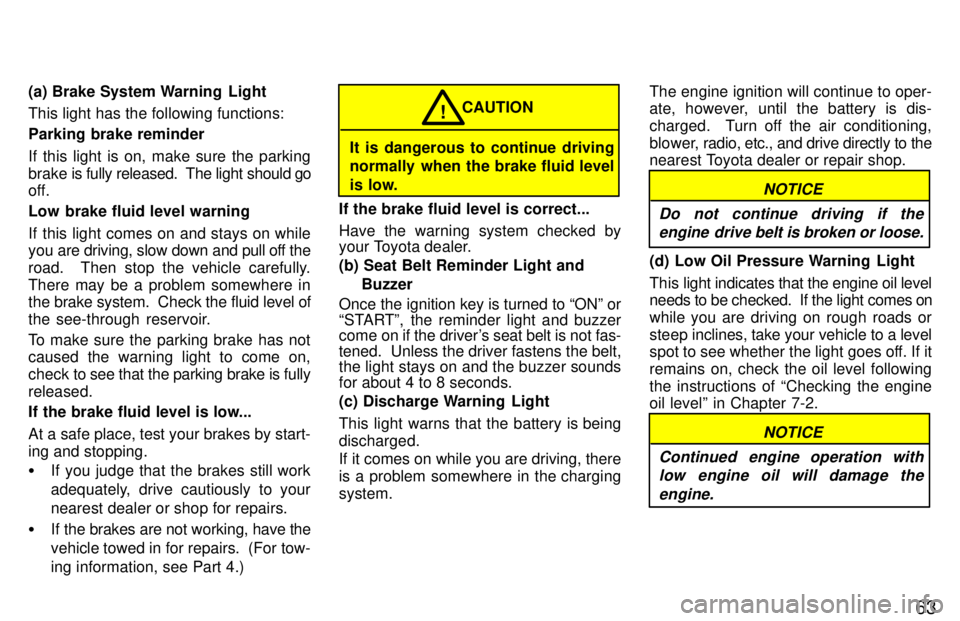
63
(a) Brake System Warning Light This light has the following functions: Parking brake reminder
If this light is on, make sure the parking
brake is
fully released. The light should go
off.
Low brake fluid level warning
If this light comes on and stays on while
you are driving, slow down and pull off the
road. Then stop the vehicle carefully.There may be a problem somewhere in
the brake system. Check the fluid level of
the see-through reservoir.
To make sure the parking brake has not
caused the warning light to come on,
check to see that the parking brake is fully
released.
If the brake fluid level is low...
At a safe place, test your brakes by start-
ing and stopping. � If you judge that the brakes still work
adequately, drive cautiously to yournearest dealer or shop for repairs.
� If the brakes are not working, have the
vehicle towed in for repairs. (For tow-
ing information, see Part 4.)
It is dangerous to continue driving
normally when the brake fluid level
is low. CAUTION
!
If the brake fluid level is correct...
Have the warning system checked by
your Toyota dealer. (b) Seat Belt Reminder Light and Buzzer
Once the ignition key is turned to ONº or
STARTº, the reminder light and buzzer
come on if the driver's seat belt is not fas- tened. Unless the driver fastens the belt, the light stays on and the buzzer sounds for about 4 to 8 seconds.
(c) Discharge Warning Light
This light warns that the battery is being discharged.
If it comes on while you are driving, there
is a problem somewhere in the chargingsystem. The engine ignition will continue to oper-
ate, however, until the battery is dis-
charged. Turn off the air conditioning,
blower, ra
dio, etc., and drive directly to the
nearest Toyota dealer or repair shop.
NOTICE
Do not continue driving if the engine drive belt is broken or loose.
(d) Low Oil Pressure Warning Light
This light indicates that the engine oil level
needs to be checked. If the light comes on
while you are driving on rough roads orsteep inclines, take your vehicle to a level
spot to see whether the light goes off. If itremains on, check the oil level followingthe instructions of Checking the engine
oil levelº in Chapter 7-2.
NOTICE
Continued engine operation with low engine oil will damage the
engine.
Page 97 of 159

122
FUNCTIONS OF ENGINE OIL
Engine oil has the primary functions of lubri-
cating and cooling the inside of the engine,
and plays a major role in maintaining the
engine in proper working order. ENGINE OIL CONSUMPTION
It is normal that an engine should con-
sume some engine oil during normal
engine operation. The causes of oil
consumption in a normal engine are
as follows. �
Oil is used to lubricate pistons, piston
rings and cylinders. A thin film of oil isleft on the cylinder wall when a piston
moves downwards in the cylinder.
High negative pressure generated
when the vehicle is decelerating sucks
some of this oil into the combustion
chamber. This oil as well as some part
of the oil film left on the cylinder wall is
burned by the high temperature com-
bustion gases during the combustionprocess. �
Oil is also used to lubricate the stems
of the intake valves. Some of this oil is
sucked into the combustion chamber
together with the intake air and is
burned along with the fuel. High tem- perature exhaust gases also burn the
oil used to lubricate the exhaust valve stems.
The amount of engine oil consumed de-
pends on the viscosity of the oil, the
quality of the oil and the conditions the
vehicle is driven under.
More oil is consumed by high- speed driving
and frequent acceleration and deceleration.
A new engine consumes more oil, since its
pistons, piston rings and cylinder walls have
not become conditioned.
When judging the amount of oil con-
sumption, note that the oil may become
diluted and make it difficult to judge the
true level accurately. As an example, if a vehicle is used for re-
peated short trips, and consumes a normal
amount of oil, the dipstick may not show
any drop in the oil level at all, even after
1000 km (600 miles) or more. This is be-
cause the oil is gradually becoming diluted
with the fuel or moisture, making it appear
that the oil level has not changed.
The diluting ingredients evaporate out
when the vehicle is then driven at high
speeds, as on an expressway, making it appear that oil is excessively consumed
after driving as high speeds.
IMPORTANCE OF ENGINE OIL LEVELCHECK
One of the most important points in proper vehicle maintenance is to keep the engine
oil at the optimum level so that oil function
will
not be impaired. Therefore, it is essen-
tial that the oil level be checked regularly.
Toyota recommends that the oil level bechecked every time you refuel the vehicle.
NOTICE
Failure to check the oil level regularly could lead to serious
engine trouble due to insufficient oil.
Facts about engine oil consumption
Page 98 of 159
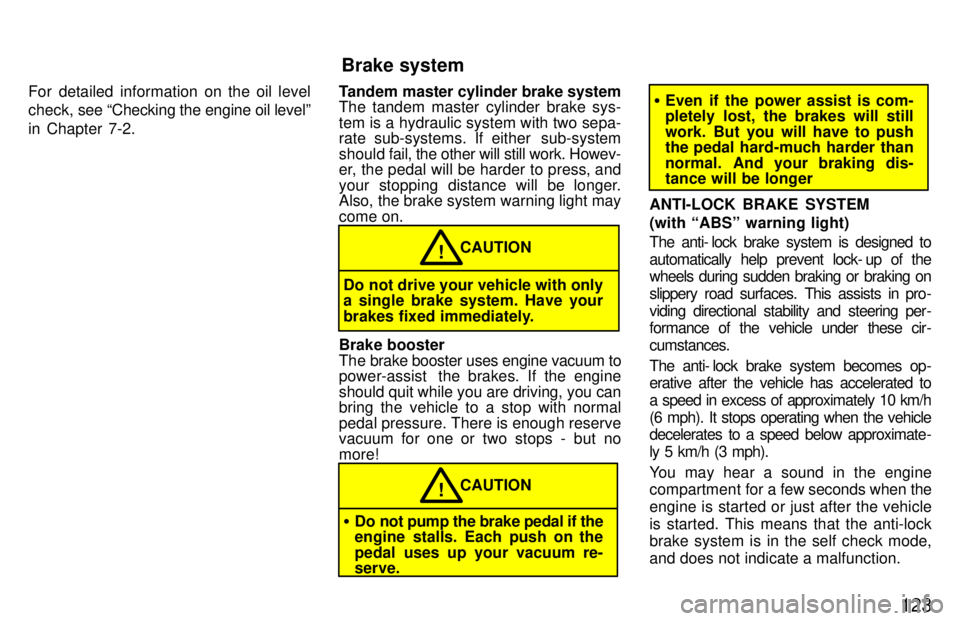
123
For detailed information on the oil level
check,
see Checking the engine oil levelº
in Chapter 7-2. Tandem master cylinder brake system
The tandem master cylinder brake sys-
tem is a hydraulic system with two sepa-
rate sub-systems. If either sub-system
should fa
il, the other will still work. Howev-
er, the pedal will be harder to press, and
your stopping distance will be longer.
Also, the brake system warning light may come on.
CAUTION!
Do not drive your vehicle with only
a single brake system. Have your
brakes fixed immediately.
Brake booster
The brake booster uses engine vacuum to
power-assist the brakes. If the engine
should quit while you are driving, you can
bring the vehicle to a stop with normal
pedal pressure. There is enough reserve
vacuum for one or two stops - but no more!
CAUTION!
� Do not pump the brake pedal if the
engine stalls. Each push on the
pedal uses up your vacuum re- serve.
�Even if the power assist is com-
pletely lost, the brakes will still
work. But you will have to push
the pedal hard-much harder than
normal. And your braking dis- tance will be longer
ANTI-LOCK BRAKE SYSTEM (with ABSº warning light)
The anti- lock brake system is designed to
automatically help prevent lock- up of the
wheels during sudden braking or braking on
slippery road surfaces. This assists in pro-
viding directional stability and steering per -
formance of the vehicle under these cir -
cumstances.
The anti- lock brake system becomes op-
erative after the vehicle has accelerated to
a speed in excess of approximately 10 km/h
(6 mph). It stops operating when the vehicle
decelerates to a speed below approximate-
ly 5 km/h (3 mph).
You may hear a sound in the engine
compartment for a few seconds when the
engine is started or just after the vehicle is started. This means that the anti-lock
brake system is in the self check mode,
and does not indicate a malfunction.
Brake system
Page 107 of 159
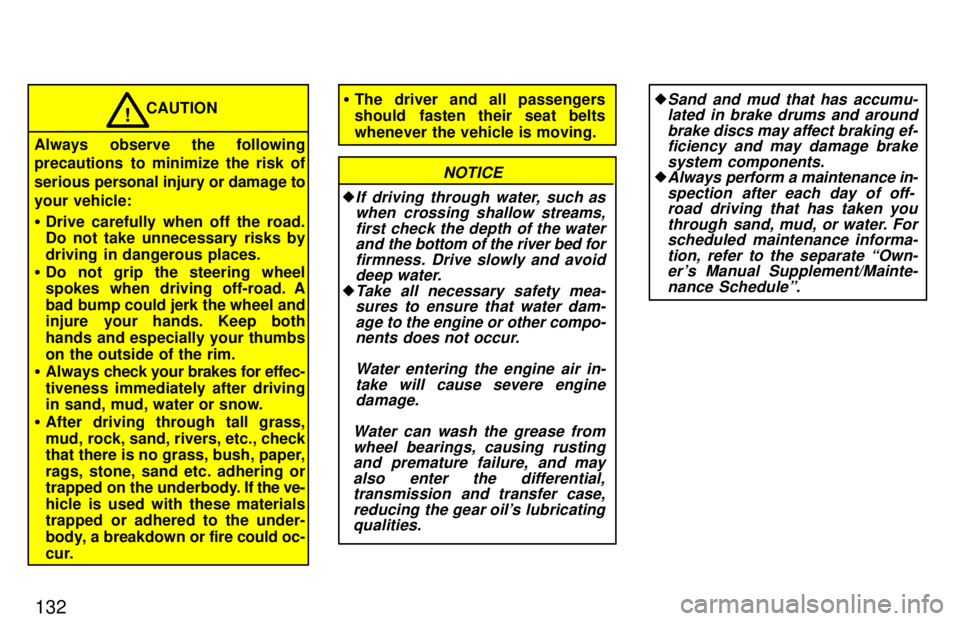
132
CAUTION
Always observe the following
precautions to minimize the risk of
serious per sonal injury or damage to
your vehicle: � Drive carefully when off the road.
Do not take unnecessary risks by
driving in dangerous places.
� Do not grip the steering wheel
spokes when driving off-road. A
bad bump could jerk the wheel and
injure your hands. Keep both
hands and especially your thumbson the outside of the rim.
� Always check your brakes for effec-
tiveness immediately after driving
in sand, mud, water or snow.
� After driving through tall grass,
mud, rock, sand, rivers, etc., check
that there is no grass, bush, paper,
rags, stone, sand etc. adhering or
trapped on the underbody. If the ve-
hicle is used with these materials
trapped or adhered to the under-
body, a breakdown or fire could oc-
cur.!
� The driver and all passengers
should fasten their seat belts
whenever the vehicle is moving.
�
If driving through water, such as when crossing shallow streams,
first check the depth of the waterand the bottom of the river bed for
firmness. Drive slowly and avoiddeep water.
�Take all necessary safety mea-sures to ensure that water dam-
age to the engine or other compo-nents does not occur.
Water entering the engine air in-take will cause severe enginedamage.
Water can wash the grease fromwheel bearings, causing rustingand premature failure, and may
also enter the differential,transmission and transfer case,
reducing the gear oil's lubricatingqualities.
NOTICE
�Sand and mud that has accumu-lated in brake drums and around
brake discs may affect braking ef-ficiency and may damage brake
system components.
�Always perform a maintenance in-
spection after each day of off-road driving that has taken you
through sand, mud, or water. Forscheduled maintenance informa-
tion, refer to the separate Own-er's Manual Supplement/Mainte-
nance Scheduleº.
Page 108 of 159
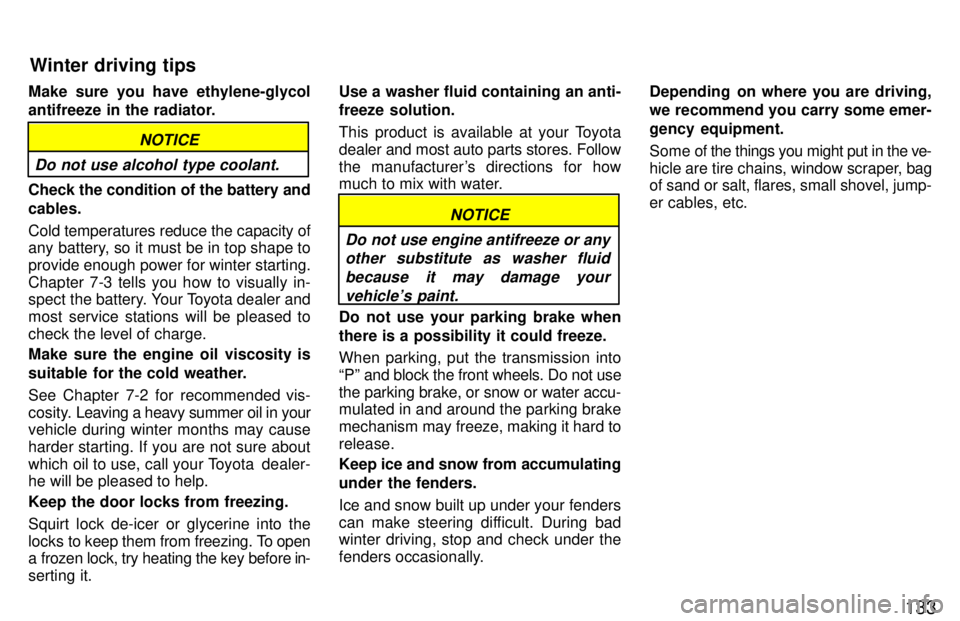
133
Make sure you have ethylene-glycol
antifreeze in the radiator.
Do not use alcohol type coolant.
NOTICE
Check the condition of the battery and cables. Cold temperatures reduce the capacity of
any battery, so it must be in top shape to provide enough power for winter starting.Chapter 7-3 tells you how to visually in-
spect the battery. Your Toyota dealer and
most service stations will be pleased tocheck the level of charge.
Make sure the engine oil viscosity is
suitable for the cold weather.
See Chapter 7-2 for recommended vis-
cosity.
Leaving a heavy summer oil in your
vehicle during winter months may cause
harder starting. If you are not sure about
which oil to use, call your Toyota dealer- he will be pleased to help. Keep the door locks from freezing. Squirt lock de-icer or glycerine into the
locks to keep them from freezing. To open
a frozen lock, try heating the key before in-serting it. Use a washer fluid containing an anti-
freeze solution.
This product is available at your Toyota
dealer and most auto parts stores. Follow
the manufacturer's directions for how
much to mix with water.
Do not use engine antifreeze or any
other substitute as washer fluid
because it may damage yourvehicle's paint.
NOTICE
Do not use your parking brake when there is a possibility it could freeze. When parking, put the transmission into
Pº and block the front wheels. Do not usethe parking brake, or snow or water accu- mulated in and around the parking brake
mechanism may freeze, making it hard torelease. Keep ice and snow from accumulating
under the fenders.
Ice and snow built up under your fenders
can make steering difficult. During bad winter driving, stop and check under the
fenders occasionally. Depending on where you are driving,
we recommend you carry some emer- gency equipment.
Some of
the things you might put in the ve-
hicle are tire chains, window scraper, bag of sand or salt, flares, small shovel, jump- er cables, etc.
Winter driving tips
Page 116 of 159
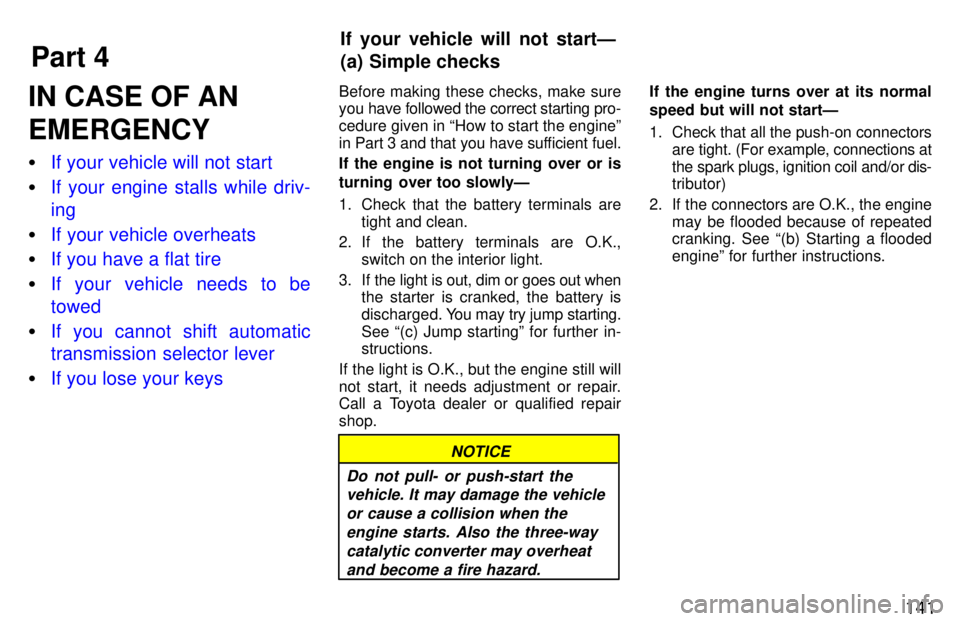
Part 4If your vehicle will not startÐ
(a) Simple checks
141
IN CASE OF AN EMERGENCY �
If your vehicle will not start
�If your engine stalls while driv- ing
�If your vehicle overheats
�If you have a flat tire
�If your vehicle needs to be towed
�If you cannot shift automatic
transmission selector lever
�If you lose your keys
Before making these checks, make sure
you have followed the correct starting pro-
cedure given in How to start the engineº
in Part 3 and that you have sufficient fuel.
If the engine is not turning over or is
turning over too slowlyÐ
1. Check that the battery terminals are
tight and clean.
2. If the battery terminals are O.K., switch on the interior light.
3. If the light is out, dim or goes out when the starter is cranked, the battery is
discharged. You may try jump starting.
See (c) Jump startingº for further in- structions.
If the light is O.K., but the engine still will
not start, it needs adjustment or repair.
Call a Toyota dealer or qualified repair shop.
NOTICE
Do not pull- or push-start the vehicle. It may damage the vehicle
or cause a collision when theengine starts. Also the three-way catalytic converter may overheatand become a fire hazard.
If the engine turns over at its normal
speed but will not startÐ
1. Check that all the push-on connectors are tight. (For example, connections at the spark plugs, ignition coil and/or dis-
tributor)
2. If the connectors are O.K., the engine may be flooded because of repeated
cranking. See (b) Starting a flooded
engineº for further instructions.